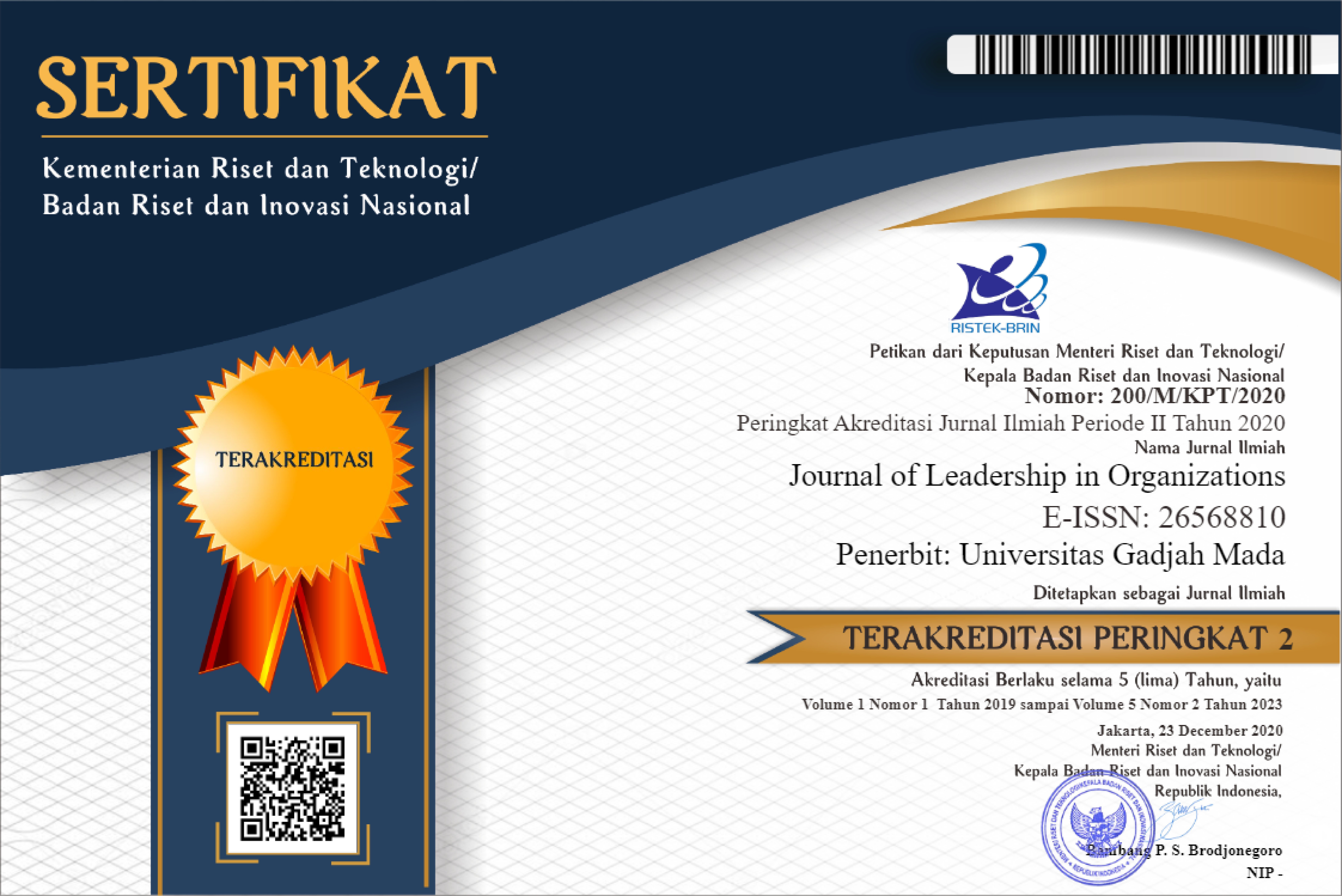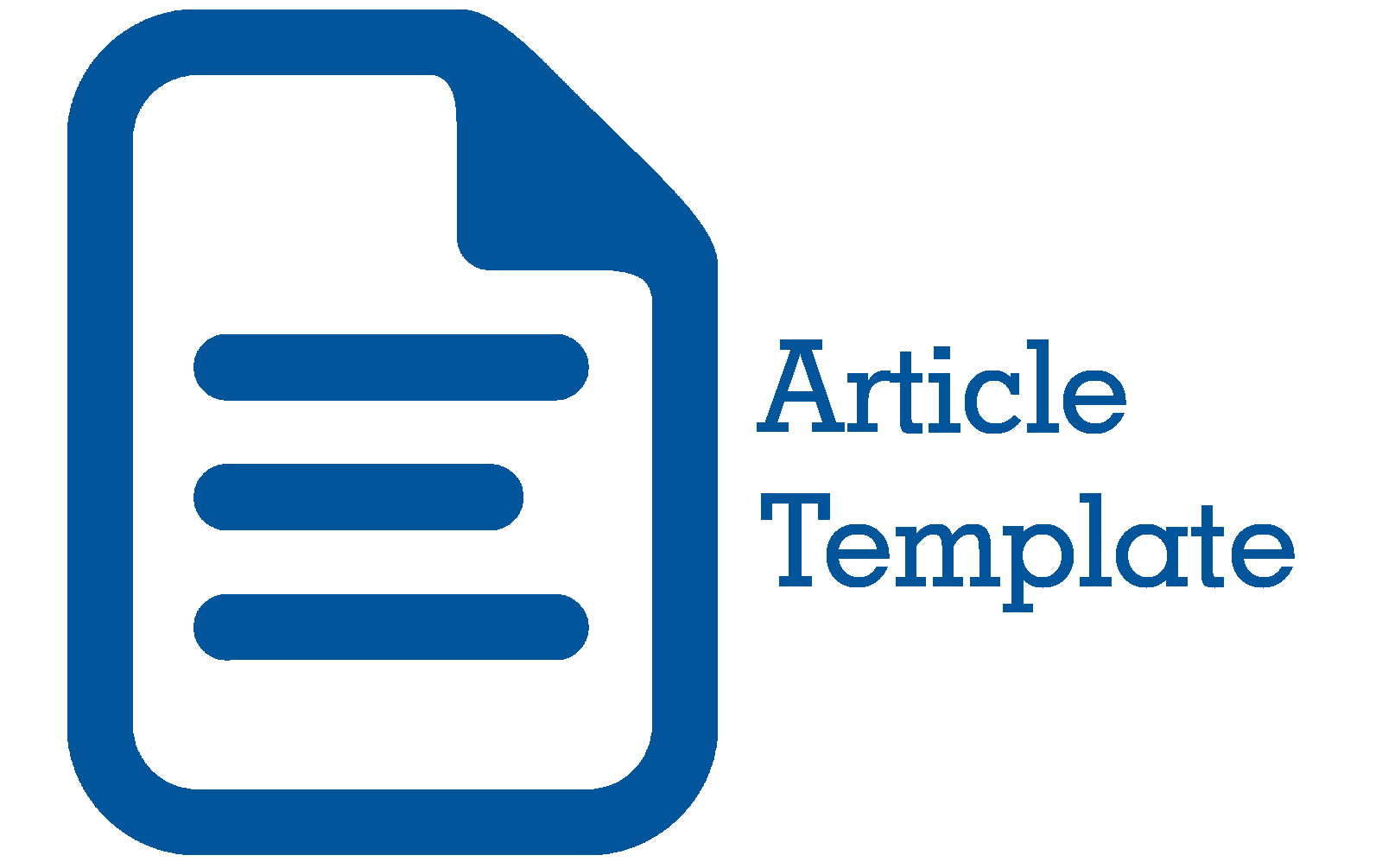Author Guidelines
The Author’s Guideline of The Journal of Leadership in Organizations since the publication year of 2019
1. Introduction
Journal of Leadership in Organizations (JLO), with registered number ISSN 2656-8829 (Print) and ISSN 2656-8810 (Online), is a peer-reviewed journal published twice a year (March and August) by the Center for Leadership Studies, Department of Management, Faculty of Economics and Business, Universitas Gadjah Mada. The Journal of Leadership in Organizations (JLO) is intended to be the journal for publishing articles reporting the results of research on leadership.
Online Journal of Leadership in Organizations was available since March 1, 2019, or since the release of Volume 1, Number 1, Year 2019. This journal was indexed in Garba Rujukan Digital (Garuda), ROAD, DOAJ, Dimensions, and SINTA 2. The Journal of Leadership in Organization (JLO) editorial board invites you to submit your manuscript to be published in this journal. The example of writing format article is HERE.
2. How to Write the Title, the Name, and the Author’s Address
The title of the manuscript should be written on the top of the first page with the center text alignment. Meanwhile, the author’s name (without academic degree), and the affiliation address of the author should be written with the center text alignment also under the title of the article. The author should give two line spaces between the title and the author’s name. Then, the space between the author’s affiliation address and the abstract title is one space. The keywords must be written below the overall abstract for all words. Those should be arranged in alphabetical order and be separated by semicolon maximally three to five words. Moreover, the title of the article that is written in Bahasa Indonesia should be also stated in English either (look at the example above).
The responsible author, the correspondence author, or the corresponding author must be written first and then followed by the second, the third, and so on. The communication regarding the article revision and the final statement will be informed via email to the correspondence author only. If there is more than one author, the author’s names should be written down separately by comma (,). If the author’s name consists of at least two words, the first name should not be shorted. If the author’s names are only one word, it should be written as it is. However, in the online version, it will be written in two words with the same name repeatedly for the purpose of the metadata indexing. (Camdali and Tunc, 2006; Fridman, 2008).
3. The Manuscript General Guidelines
The manuscript text general guidelines are as follows:
- The manuscript is the authentic research result that has not been published yet in other publication media or publishing houses.
- The manuscript should be written in English with the standard language. The manuscript text ought to be written as this article template. The article is written on A4-sized papers (210x297 mm), with custom margins as follows: left 25 mm, right 20 mm, bottom 20 mm and top 30 mm, Time New Roman theme font, 12pt font size, and 1.5 line-spacing.
- The manuscript is typed using Microsoft Word program on A4 paper, around 3,000-9,000 words including figures, tables, and references.
- The manuscript does not contain any plagiarism elements. The editorial board will directly reject the text that indicates plagiarism.We use plagiarism software to check your manuscript.
- The manuscript that has been written under the guidelines of The Journal of Leadership in Organization (JLO) (in MS Word format, use this article template) must be submitted through Online Submission System using Open Journal System (OJS) on The Journal of Leadership in Organization (JLO) E-journal portal (http://journal.ugm.ac.id/leadership) choose only one procedure. Then, register as one of the authors or reviewers in the “Register” bottom.
- The manuscript article writing guidelines and template can be downloaded. The template and the guidelines of the article writing are available in MS Word (.doc) format.
- The manuscript online submission can be viewed in the part of the online submission guidelines below.
- The manuscript which is inappropriate with The Journal of Leadership in Organization (JLO) writing guidelines will be returned to the author before the reviewing process.
- The manuscript should contain several aspects of a scientific article as follows: (subtitles as the order), which are: (a) the title of the article, (b) the author’s name (no academic title), (c) the affiliated author’s address, (d) the author’s email (e) the abstract and the keywords, (f) the introduction, (g) the research method, (h) the research findings and discussion, (i) the conclusion, (j) acknowledgement, (k) the references.
- The subtitles included in the discussion part (Introduction, Methods, Findings and Discussion, and Conclusion) should not be numbered. The subtitles are written in the bold and title case format. It uses the left text alignment without an underline. The next expanded subtitles should be written in the bold and sentence case format, It should use the left text alignment and the numbering format level two.
- The words from uncommon or foreign languages are stated in Italic format. Each paragraph started 10mm from the left side border while there are no spaces among paragraphs. All numbers are written in Arabic numbering format, except for the new sentence.
- The tables and pictures are placed in the text group after the referenced tables or pictures. Each picture must be given a caption and source (Figure Caption) below the picture and be numbered in Arabic numbering format followed by the picture title. Each table must be given a table title (Table Caption) and numbered in Arabic numbering format above the table followed by the table title and source below the table. The pictures attachment should be guaranteed that they can be printed well in black and white ink (font size, resolution and line space are clearly seen). The picture, the table, and the chart should be placed in the center between text groups. If it has a bigger size, it can be placed in the center of a page. The table should not contain vertical lines, while horizontal lines are allowed only for the important point.
4. The Guidelines for the Manuscript Body Text
The title of the manuscript: The title should be informative and be written both briefly and clearly. It cannot diverse multi interpretations. It has to be pinpoint with the issues that will be discussed. The beginning word is written in a capital case and symmetrically. The article title does not contain any uncommon abbreviations. The main ideas should be written first and followed then by its explanations. The article title should be written within twelve words, 14pt-sized font, with the bold selection and in the center text format.
Abstract: The abstract has to be written within 150-250 words maximum and followed by three to five keywords and arranged alphabetically. Abstract must contain research objectives, methods, results, conclusions, and limitations (optional). Abstract written in 1 space line and 12 font size Times New Roman.
Introduction: The introduction must contain (shortly and consecutively) a general background and a literature review (state of the art) as the basis of the brand new research question, statements of the brand new scientific article, main research problems, and the hypothesis. In the final part of the introduction, the purpose of the article writing should be stated. They should be represented in the literature review to show the brand new of the scientific article.
Methods: The method explains how the research is conducted, including research design, data collection, research instrument, and analytic methods. This part should be narrated.
Findings and Discussion: This part consists of the research results and how they are discussed. The results obtained from the research have to be supported by sufficient data. The research results and the discovery must be the answers or the research hypothesis or research question stated previously in the introduction part.
Conclusion: This is the final part containing conclusions, limitations and recommendations. The conclusions will be the answers of the hypothesis or research question, the research purposes and the research discoveries. The conclusions should not contain only the repetition of the results and discussions. It should be the summary of the research results as the author expects in the research purposes or the hypothesis. Research limitations and recommendations contain a deficiency in the research and suggestions associated with further ideas from the research.
Acknowledgment: Acknowledgements to those who support the research (sponsors and respondents). Families and supervisors are not allowed in this section.
References: All the references used in the article must be listed in this part. In this part, all the used references must be taken from primary sources (scientific journals and the least number is 80% of all the references) published in the last ten years.
5. The Guidelines for the Citations and References
All the served data or quotes in the article taken from the other author articles should attach the reference sources. The references should use a reference application management such as Mendeley, End Note, or Zotero. The writing format used in The Journal of Leadership in Organization (JLO) follows the format applied by APA 6th Edition (American Psychological Association).
6. The Online Submission Manuscript Guidelines
The manuscript text must be submitted by one of two systems (s the second procedure is more preferable):
- The document should be submitted by the Online Submission System in The Journal of Leadership in Organization (JLO) E-journal portal HERE.
- Firstly, the author should register as either an author or reviewer (checking role as author or reviewer).
- After the registration step is completed, log in as an author, click in “New Submission”. The article submission stage consists of five stages, such as: (1). Start, (2). Upload Submission, (3). Enter Metadata, (4). Upload Supplementary Files, (5). Confirmation.
- In the “Start” column, chose the Journal Section (Full Article), check all the checklists.
- In the “Upload Submission” Column, upload the manuscript files in MSWord format in this column.
- In the “Enter Metadata” columns, fill in with all the author data and affiliation. Including the Journal Title, Abstract and Indexing Keywords.
- In the “Upload Supplementary Files” columns, the author is allowed to upload supplementary files, the statement letter, or any other else.
- In the “Confirmation” columns, if the data you entered are all correct already, then click “Finish Submission”.
- If the author has difficulties in the submission process through the online system, please contact The Journal of Leadership in Organization (JLO) editorial team at jlo.feb@ugm.ac.id.





_logo2.png)


.png)




